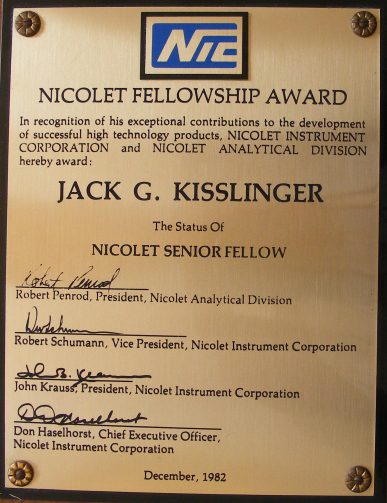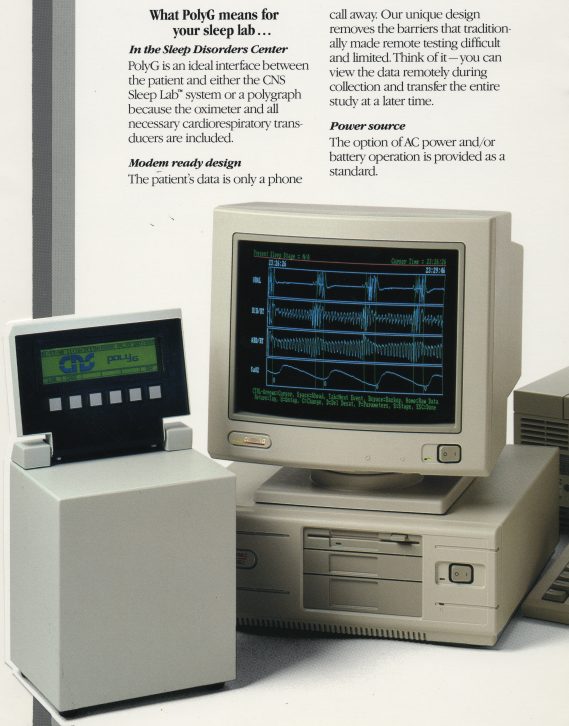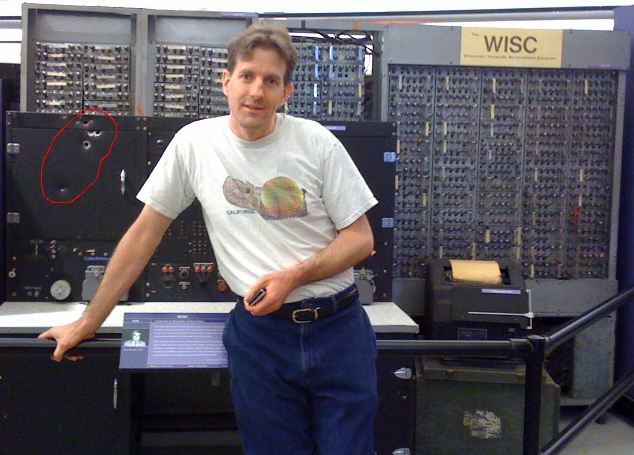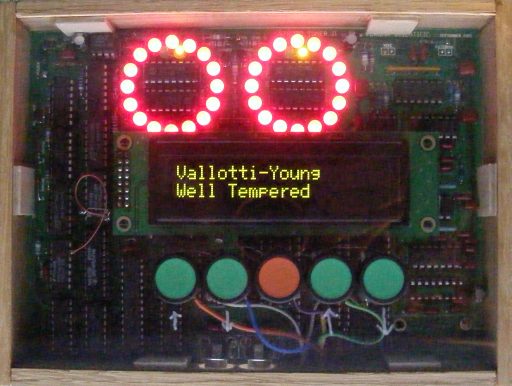Personal Notes
Nicolet Senior Fellow
 There was an awards ceremony at the posh Madison Club in 1982. The speakers
included the Dean of the UW engineering school. The fellow awards were Jack Krauss's idea.
In his speech he explained that Nicolet had a dual track system. There was a management
track and a technology track and they were equally important, equally prestigious and
equally remunerative. I appreciated the sentiment. In his speech Jack Krauss also pointed
out that my technological contributions accounted for 100 million dollars for Nicolet and
the local economy.
There was an awards ceremony at the posh Madison Club in 1982. The speakers
included the Dean of the UW engineering school. The fellow awards were Jack Krauss's idea.
In his speech he explained that Nicolet had a dual track system. There was a management
track and a technology track and they were equally important, equally prestigious and
equally remunerative. I appreciated the sentiment. In his speech Jack Krauss also pointed
out that my technological contributions accounted for 100 million dollars for Nicolet and
the local economy.
My departure from Nicolet in 1988
Not to put too fine a point on it, I was fired. I did not see it coming. I went on a solo packpacking trip near Lake Superior to think about it.
My consulting career begins at CNS
 I
came back to Madison and connected with Don Erickson. He had left Nicolet and was the R&D
manager at CNS, a Minneapolis based company that manufactured a sleep analysis system.
Don's idea was to develop a sleep analysis system that a patient could use at home. Not
everyone can sleep in a hospital while connected to machines so it seemed like a good idea
to me. He asked me if I would design it. CNS was located in Eden Prairie, Minnesota, so I
called it the Prairie (dog) Home Companion. CNS employees thought this pretty funny. They
hired a professional cartoonist to do a rendition of a prairie dog as seen through a
telescopic gun sight.
I
came back to Madison and connected with Don Erickson. He had left Nicolet and was the R&D
manager at CNS, a Minneapolis based company that manufactured a sleep analysis system.
Don's idea was to develop a sleep analysis system that a patient could use at home. Not
everyone can sleep in a hospital while connected to machines so it seemed like a good idea
to me. He asked me if I would design it. CNS was located in Eden Prairie, Minnesota, so I
called it the Prairie (dog) Home Companion. CNS employees thought this pretty funny. They
hired a professional cartoonist to do a rendition of a prairie dog as seen through a
telescopic gun sight.
The Prairie Dog was demonstrated at a trade show 8 months later. It was successful and it
went into production. However, CNS management lost interest in the Prairie Dog and they
sold the rights to a Danish company. CNS management became interested in a little thing you stick to
your nose. It was called the Breathe Right nasal strip. It
was suppose to cure snoring, allergies and nasal congestion. It may seem ridiculous, but
CNS was sold to GlaxoSmithKline for a cool
$566 million in 2006. I never would have predicted it.
Don Erickson left CNS and became a R&D manager at Medtronics, a large Minneapolis based
company known for pacemakers. The Prairie Dog was very successful in Europe. This is what
it looked like: (The official name was PolyG.)

My consulting career continues at Medtronics
Don Erickson, now at Medtronics, continues to use me as a consultant. There were several
projects but the most notable was the battery operated "stim" box. It was a general
purpose device that could be programmed to produce physiologically useful electrical
stimuli. The East Germans used electrical devices to enhance the performance of Olympic
athletes. The same methods could be adapted to strengthen muscles of patients with medical
problems.
Medtronics, as you might imagine, has an active legal department. I was not allowed to
test the stim box on anyone except Don and myself. Programming errors could (and did) lead
directly to pain.
My consulting career continues at Advanced Fuel Research (AFR)
 Advanced Fuel was in the process of developing a new FTIR spectrometer and they needed
someone to design a data system for it. I was thoroughly vetted at Nicolet before they
contacted me. The fastest microcomputer you could buy at the time was the Motorola 68030
with the companion floating point processor, the 68882. I designed a true, 32 bit FTIR data
system with them. It was smaller, cheaper and faster than the Nicolet 1280. It was the
little board stuck in a corner of the spectrometer that Nicolet needed.
Advanced Fuel was in the process of developing a new FTIR spectrometer and they needed
someone to design a data system for it. I was thoroughly vetted at Nicolet before they
contacted me. The fastest microcomputer you could buy at the time was the Motorola 68030
with the companion floating point processor, the 68882. I designed a true, 32 bit FTIR data
system with them. It was smaller, cheaper and faster than the Nicolet 1280. It was the
little board stuck in a corner of the spectrometer that Nicolet needed.
Steve Jobs was designing the "NeXT"
computer at the same time. He used the same part for the same reasons, but mine ran at
40MHz and his ran at 25MHz. The NeXT computer eventually became the Apple Macintosh. The completed
FTIR spectrometer was demonstrated at the Pittsburgh Conference in 1994. It was supposed
to fly in an unmanned helicopter that looked for Saddam Hussein's nerve gas. Few were sold and it never
went into real production.
The AFR project led to a patent.
http://www.freepatentsonline.com/7436234.pdf
My consulting winds down
There are more interesting tales to tell. They range from the ridiculous (a sound system for a bounce house) to the bizarre (a controller for a Nicolet X-ray microscope) to the esoteric (an infrared detector implemented with nanotechnology.) But my connection with the Fourier revolution ends and so I will stop here.
A tragedy
My friend Don Erickson dies of a malignant melanoma. Don was the kindest, the most honest and hardest working person I have ever met. He is sorely missed.
Why did I write this website?
 I visited the computer museum in Mountain
View, California in the fall of 2008. I saw many interesting things, but one thing had
particular meaning for me. It was Gene
Amdahl's first computer, the WISC. I had seen it before in the basement of my mentor,
John McNall, in 1965. McNall had used it as the basis of a business. The WISC was built in
1952 and it was Wisconsin's first computer. Amdahl went on to design the IBM 360, the IBM
370 and then the Amdahl 470 at his own company. He was also an IBM Fellow. What surprised
me was the bullet holes in the WISC. The bullet holes were made by a large caliber pistol
according to a certain ballistics expert. The WISC is a
little hard to find. It is behind the very prominent SAGE computer.
That's my son, Kim, in front of the WISC
I visited the computer museum in Mountain
View, California in the fall of 2008. I saw many interesting things, but one thing had
particular meaning for me. It was Gene
Amdahl's first computer, the WISC. I had seen it before in the basement of my mentor,
John McNall, in 1965. McNall had used it as the basis of a business. The WISC was built in
1952 and it was Wisconsin's first computer. Amdahl went on to design the IBM 360, the IBM
370 and then the Amdahl 470 at his own company. He was also an IBM Fellow. What surprised
me was the bullet holes in the WISC. The bullet holes were made by a large caliber pistol
according to a certain ballistics expert. The WISC is a
little hard to find. It is behind the very prominent SAGE computer.
That's my son, Kim, in front of the WISC
The museum visit triggered this website.
A little about me
 My name is Jack Kisslinger and I live with Peg, my wife, in Madison, Wisconsin. I have two
sons, Eric and Kim. I am pretty much retired.
My name is Jack Kisslinger and I live with Peg, my wife, in Madison, Wisconsin. I have two
sons, Eric and Kim. I am pretty much retired.
I call my consulting business Verona Scientific for a simple reason. I lived in Verona
when I started out as a consultant 21 years ago. I bought the versci.com URL figuring it
might be useful for my business.
I maintain another website. It deals with the energy crisis and related issues, for
example; the hydrogen economy.
http://www.planetforlife.com/
I used HTML-Kit to create this website. It is
complex, complete and non-WYSIWYG. It is free and, most important, it does not do strange
things. I have used it daily for months without problems.
I am a maniacal, but friendly, tennis player. I still do solo packpacking around Lake
Superior.
 I have a strong interest in music. I love to play the piano and I have become interested in
temperaments.
I have designed a stroboscopic piano tuner that makes it relatively easy to put historical
tunings on my piano.
Valotti-Young refers to
a temperament Chopin or Schubert might have heard. My strobotuner has a dozen or so
temperaments stored in it. Here is a description of a very old mechanical strobotuner.
I have a strong interest in music. I love to play the piano and I have become interested in
temperaments.
I have designed a stroboscopic piano tuner that makes it relatively easy to put historical
tunings on my piano.
Valotti-Young refers to
a temperament Chopin or Schubert might have heard. My strobotuner has a dozen or so
temperaments stored in it. Here is a description of a very old mechanical strobotuner.
I am currently working on a hand held device that can graphically illustrate inharmonicity.
 A visiting grandson had a Rubik's cube. He lost interest, but it became an obsession for me.
I was able to solve it after an amount of time I would rather not say. I wrote a Javascript program
to simulate Rubik's cube. Click the cube to try it.
A visiting grandson had a Rubik's cube. He lost interest, but it became an obsession for me.
I was able to solve it after an amount of time I would rather not say. I wrote a Javascript program
to simulate Rubik's cube. Click the cube to try it.
![]() Here is my email address. It is not clickable because it
is a picture. I am trying to make it hard for spammers. I would very much like to hear
from anyone on any subject.
Here is my email address. It is not clickable because it
is a picture. I am trying to make it hard for spammers. I would very much like to hear
from anyone on any subject.